
Sceliphron caementarium, also known as the yellow-legged mud-dauber wasp, black-and-yellow mud dauber, or black-waisted mud-dauber, is a species of sphecid wasp. There are some 30 other species of Sceliphron that occur throughout the world, though in appearance and habits they are quite similar to S. caementarium.
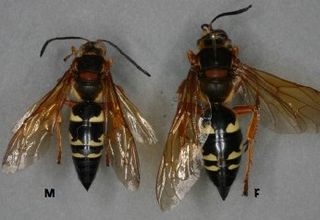
Sphecius speciosus, often simply referred to as the cicada killer or the cicada hawk, is a large, solitary digger wasp species in the family Crabronidae. The name may be applied to any species of crabronid that preys on cicadas, though in North America, it is typically applied to this species, also referred to as the eastern cicada killer in order to further differentiate it from the multiple other examples of related wasp species. Sometimes, they are called sand hornets, although they are not hornets, which belong to the family Vespidae. This species can be found in the Eastern and Midwest U.S. and southwards into Mexico and Central America. They are so named because they hunt cicadas and provision their nests with them. Cicada killers exert a measure of natural control on cicada populations, and as such, they may directly benefit the deciduous trees upon which the cicadas feed.
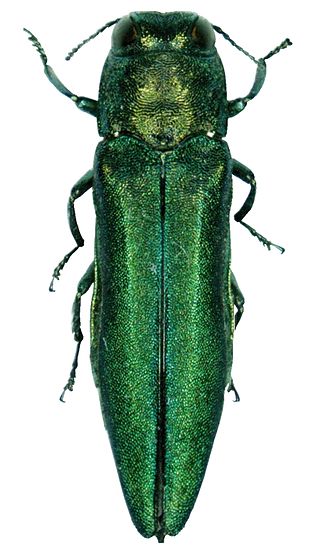
The emerald ash borer, also known by the acronym EAB, is a green buprestid or jewel beetle native to north-eastern Asia that feeds on ash species. Females lay eggs in bark crevices on ash trees, and larvae feed underneath the bark of ash trees to emerge as adults in one to two years. In its native range, it is typically found at low densities and does not cause significant damage to trees native to the area. Outside its native range, it is an invasive species and is highly destructive to ash trees native to Europe and North America. Before it was found in North America, very little was known about emerald ash borer in its native range; this has resulted in much of the research on its biology being focused in North America. Local governments in North America are attempting to control it by monitoring its spread, diversifying tree species, and through the use of insecticides and biological control.

Mud dauber is a name commonly applied to a number of wasps from either the family Sphecidae or Crabronidae which build their nests from mud; this excludes members of the family Vespidae, which are instead referred to as "potter wasps". Mud daubers belong to different families and are variable in appearance. Most are long, slender wasps about 1 inch (25 mm) in length. The name refers to the nests that are made by the female wasps, which consist of mud molded into place by the wasp's mandibles. Mud daubers are not normally aggressive, but can become belligerent when threatened. Stings are uncommon.

The organ pipe mud dauber is a predatory wasp in the family Crabronidae. It is fairly large, ranging from 3.9–5.1 cm, and has been recorded to fly from May to September. Females and males are similar in colour, a shiny black, with the end part of the back leg being pale yellow to white. The organ pipe mud dauber feeds mainly on three genera of spider: Neoscona, Araneus, and Eustala. Melittobia, a parasitoid wasp, is a common ectoparasite of T. politum prepupae. Other sources of parasitism include the bombyliid fly Anthrax, chrysidid wasps, and various species of scavenger flies (Miltogramminae). The tufted titmouse is a known predator of T. politum, and may feed on them more commonly than previously thought, as the holes made by the titmouse are similar in shape and size to those made by T. politum leaving the nest after pupation.

Potter wasps, the Eumeninae, are a cosmopolitan wasp group presently treated as a subfamily of Vespidae, but sometimes recognized in the past as a separate family, Eumenidae.

The European beewolf, also known as the bee-killer wasp or the bee-eating philanthus, is a solitary wasp that lives in the Western Palearctic and Afrotropics. Although the adults of the species are herbivores, the species derives its name from the behaviour of the inseminated females, who hunt Western honey bees. The female places several of its paralysed prey together with an egg in a small underground chamber, to serve as food for the wasp larvae. All members of the genus Philanthus hunt various species of bees, but P. triangulum is apparently the only one that specialises in Western honey bees.
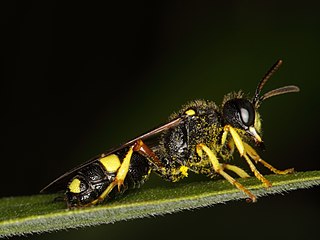
Cerceris is a genus of wasps in the family Crabronidae. It is the largest genus in the family, with over 1030 described species and subspecies. The genus has a cosmopolitan distribution, with species on every continent.
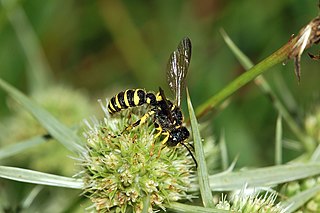
The subfamily Philanthinae is one of the largest groups in the wasp family Crabronidae, with about 1100 species in 9 genera, most of them in Cerceris; Alexander treats it as having only 8 genera. Historically, this subfamily has frequently been accorded family status. The subfamily consists of solitary, predatory wasps, each genus having its own distinct and consistent prey preferences. The adult females dig tunnels in the ground for nesting.
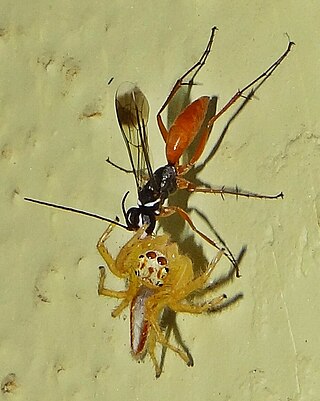
Mass provisioning is a form of parental investment in which an adult insect, most commonly a hymenopteran such as a bee or wasp, stocks all the food for each of her offspring in a small chamber before she lays the egg. This behavior is common in both solitary and eusocial bees, though essentially absent in eusocial wasps.
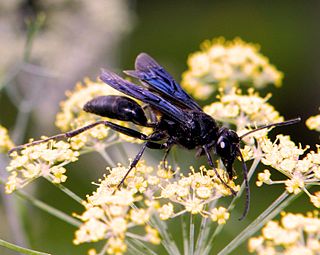
Sphex pensylvanicus, the great black wasp, is a species of digger wasp. It lives across most of North America and grows to a size of 20–35 mm (0.8–1.4 in). The larvae feed on living insects that the females paralyze and carry to the underground nest.
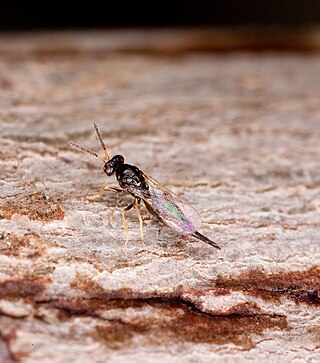
Tetrastichus planipennisi is a parasitic non-stinging wasp of the family Eulophidae which is native to North Asia. It is a parasitoid of the emerald ash borer, an invasive species which has destroyed tens of millions of ash trees in its introduced range in North America. As part of the campaign against the emerald ash borer (EAB), American scientists in conjunction with the Chinese Academy of Forestry searched since 2003 for its natural enemies in the wild leading to the discovery of several parasitoid wasps, including Tetrastichus planipennisi which is a gregarious endoparasitoid of EAB larvae on Manchurian Ash and has been recorded to attack and kill up to 50 percent of EAB larvae.

Oobius agrili is a parasitic non-stinging wasp of family Encyrtidae which is native to North Asia. It is a parasitoid of the emerald ash borer, an invasive species which has destroyed tens of millions of ash trees in its introduced range in North America. As part of the campaign against the emerald ash borer (EAB), American scientists in conjunction with the Chinese Academy of Forestry searched since 2003 for its natural enemies in the wild leading to the discovery of several parasitoid wasps, including Oobius agrili, which is a solitary egg parasitoid of EAB found on ash trees in Jilin province in 2004; it has been recorded to kill up to 60 percent of EAB eggs.
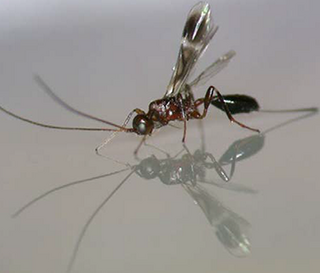
Spathius agrili is a parasitic non-stinging wasp of family Braconidae which is native to North Asia. It is a parasitoid of the emerald ash borer, an invasive species which has destroyed tens of millions of ash trees in its introduced range in North America. As part of the campaign against the emerald ash borer (EAB), American scientists in conjunction with the Chinese Academy of Forestry began searching in 2003 for its natural enemies in the wild, leading to the discovery of several parasitoid wasp species, including Spathius agrili. S. agrili was discovered in Tianjin, China where it is a prevalent parasitoid of EAB larvae in stands of an introduced ash species, and an endemic ash species. S. agrili has been recorded to attack and kill up to 90 percent of EAB larvae.
The thin-waisted social wasps, which typically reside in Neotropical regions from Central to South America, are a small genus of wasps that build nests and live in colonies ranging in size from 1 to 18 members. Microstigmus is widely considered to be the only true eusocial species within the family Crabronidae. Like all Hymenoptera, Microstigmus has an interesting sex determination pattern. Females are 2n (diploid), spawning from eggs that have been fertilized, while males are 1n (haploid) and spawn from unfertilized eggs. Female wasps contain the eggs within their egg sac and have the option of fertilizing them or not, thus having complete control of the gender of their offspring. This wasp genus, part of the suborder Apocrita, is distinguished physically by the narrow waist (petiole) between the end segment of the thorax (mesosoma) and the beginning of the abdomen (metasoma). Specifically, it is in the subgroup of "apoid wasps", those that exhibit social behavior in nesting and foraging. Evidence does exist that in some species social altruism is visible; however, studies on these topics have been limited. The small size and enclosed nest structure makes it difficult to obtain significant data. Although it was originally classified under the Sphecidae family due to its elongated petiole, Microstigmus has been reclassified into the new Crabronidae family.

Sphecius grandis, also called the western cicada killer, is a species of cicada killer wasp (Sphecius). The western species shares the same nesting biology as its fellow species, the eastern cicada killer. S. grandis, like all other species of the genus Sphecius, mainly provides cicadas for its offspring. It forms nest aggregations and mates and broods once in a year, in July and early August. The wasp is on average 3 cm (1 in) to 5 cm (2 in) in length and is amber-yellow with yellow rings on its abdomen.
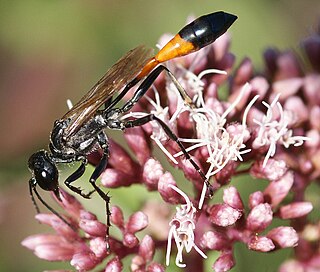
Ammophila sabulosa, the red-banded sand wasp, is a species of the subfamily Ammophilinae of the solitary hunting wasp family Sphecidae, also called digger wasps. Found across Eurasia, the parasitoid wasp is notable for the mass provisioning behaviour of the females, hunting caterpillars mainly on sunny days, paralysing them with a sting, and burying them in a burrow with a single egg. The species is also remarkable for the extent to which females parasitise their own species, either stealing prey from nests of other females to provision their own nests, or in brood parasitism, removing the other female's egg and laying one of her own instead.

Hunting wasps are members of various taxa of the insect order Hymenoptera. Their habits and affinities vary in many ways, but all practise parental care of their larvae in that they capture prey, usually insects, to feed their larvae. Whether solitary or social, most species construct some form of protection or nest in which they hide the prey and in which the larvae can feed and pupate in reasonable security.
Cerceris californica is a species of wasp in the family Crabronidae. It is found in Central America and North America. This species is a predator of Buprestidae beetles.

Palmodes occitanicus is a species of thread-waisted wasp in the family Sphecidae.






















